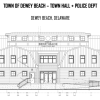Fatal crashes in the Cape Region reached a near-record high of 13, rising from eight the year before. The number of motorcycle crashes increased by more than 50 percent from 15 crashes in 2018 to 23 crashes in 2019.
Last year, 11 percent of all calls involved vehicle crashes. The number of crashes at 2,295 is consistent over the past five years, but the number of pedestrian-vehicle crashes decreased nearly 35 percent.
Those were among the statistics presented by Delaware State Police Troop 7 Capt. Darren Short and his administrative staff during a Feb. 17 year-in-review presentation to the public and elected officials at the new troop on Mulberry Knoll Road near Lewes.
While serious crashes increased, Short said in spite of rapid population growth, most crime is decreasing. For the second straight year, the troop saw record lows in numbers of thefts, robberies, burglaries, aggravated assaults and shopliftings.
Short said there were 10 fewer DUI arrests from 2018 to 2019, but 563 arrests is still a significant number, with 147 arrests the result of crashes. Statewide, 25 percent of all DUI arrests are made by Troop 7 troopers.
Drug investigations
Short said troopers place a high priority on proactive drug arrests, which reached a record high of 614 in 2019, a 73 percent increase from 2018. “We all know we have a serious addiction problem pushing crimes in the area,” he said.
The captain said proactive arrests are made by troopers who are not dispatched to a specific drug-complaint investigation. Many arrests are made during traffic stops.
With drug offenders, he said, the priority is to get them into treatment programs. “We want to get them the resources they need and get the drugs off the street for that night.
It benefits us by bringing down crime,” Short said.
The drug addiction problem has special meaning to Short, who recently lost a niece to opioid addiction. “She should have been locked up and had mandated treatment,” he said.
Route 1 is hot spot
It comes as no surprise that the Route 1 corridor between Lewes and Rehoboth Beach is not only the No. 1 hot spot for crime, but also the top spot for traffic offenses in the Delaware State Police Troop 7 territory.
Short said the core crime area includes businesses and neighborhoods along the Route 1 corridor. Data show most crimes occur from 1 to 5 a.m.
“Because of that, we have one or two cars assigned to that area almost every night during that time,” Short said.
He noted the area at the Route 1-Route 24 intersection is a priority area for patrol.
Seven percent, or 805, of all thefts from vehicles – nearly all unlocked – and 4 percent, or 388, of all shopliftings occurred along the Route 1 corridor last year.
Short said the majority of traffic offenses in the troop’s territory occur along Route 1 from the Nassau Bridge to the entrance to Rehoboth Beach, with most taking place from noon to 6 p.m., with Friday as the No. 1 day.
The top three offenses are following too close, inattentive driving and failure to yield. Patrol is stepped up in that area from noon to 4 p.m., Short said.
Using data to fight crime
Short attributed the decreases in burglaries, assaults, thefts, shopliftings and robberies to how the troop uses data to deploy its resources. The State Police Enhanced Analytical Response (SPEAR) system provides daily data on crimes and crashes to pinpoint key areas where action is needed.
“This is very effective for DSP, and very, very effective for Troop 7,” he said. “It’s not where we think we need to be, it’s using data for our day-to-day operation.”
In addition, the troop has a three-trooper Proactive Criminal Enforcement Team (PACE), which can be deployed rapidly to an area.
Nearly half of the troop’s 19,136 calls in 2019 involved noncriminal activity with no arrests such as responding to false alarms, investing suspicious people, assisting the public and dealing with disabled vehicles. “We do reach out and help people when we can. It’s really a big part of our job,” Short said.
More than 7,100 calls were criminal cases, and more than 2,100 calls were crash-related.
Troop 7 clearance rates
Short said clearance rates are a measure of how the troop performs. In 2019, troopers cleared 79 percent of aggravated assaults, 64 percent of robberies, 28 percent of burglaries, 37 percent of thefts, and 56 percent of shopliftings.
Clearance indicates that police have a suspect or an arrest has been made. Troop 7’s clearance rates top national averages in all of those categories.
Concerns about bicyclists
Several citizens in attendance asked questions about bicyclists, particularly foreign students, riding on Route 1.
Each summer about 200 students receive training, helmets and lights through the J1 International Student Outreach Program, but the majority of the nearly 1,000 students – most of whom ride bikes – receive no training.
Short said troopers stop bicyclists who do not have lights or are wearing nonreflective, dark clothing nearly every night during the summer.
“A lot of times, these are education stops. We plan to hit that much harder this summer,” he said, adding troopers sometimes install lights on bikes.
“We would hand out helmets if we had them,” he said. “We will do whatever we can. Reach out to us if you need help.”
About Delaware State Police Troop 7
Troop 7 territory includes areas from Milford to the Indian River Inlet bridge, west to Harbeson and Route 5, Ellendale, Lincoln, north of Georgetown and Long Neck Road
Troop 7 has a staff of 55, which includes four troopers in the collision reconstruction unit and three PACE troopers. Short said the troop’s goal is to have seven troopers on duty with one manning the troop’s front desk on each shift during peak times, such as summer months.
The troop also has a large K-9 unit of three attack dogs, one drug-sniffing dog and two explosive-sniffing dogs
What’s the difference?
• Burglary – Unlawful entry into a structure with the intent to commit a crime
• Robbery – Stealing property from someone using fear or force
• Theft – Taking an object without consent of the owner
Delaware State Police online
www.dsp.delaware.gov
www.facebook.com/dspnewsroom
www.twitter.com/DEStatePolice
www.nexdoor.com


























































